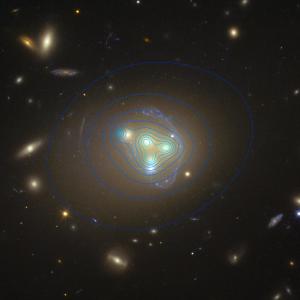Blog
The Dark Side
23 April 2015
Dark matter remains enigmatic, but we are learning more about it. While much of the observations about dark matter have determined what it’s not, there hasn’t been nearly as much data to determine what it is. So far we know that it is predominantly cold (meaning it isn’t zipping around at near light speeds) and it likely interacts with matter through the weak force and gravity. It’s generally been thought that dark matter should also be self-interacting, but recent observations haven’t shown any such interaction. But new observations of the galaxy cluster Abell 3827 show some evidence of dark matter’s self-interaction.1
 European Southern Observatory
European Southern ObservatoryOne of the ways we observe the behavior of dark matter is by looking at colliding galaxy clusters. When two galaxies collide, two things happen. First, the gas and dust in these galaxies collide and interact. When they do, they tend to combine to produce large clouds that can start producing new stars. Because interstellar gas clouds tend to be diffuse and spread across light years, they are fairly likely to interact. The stars in these galaxies, on the other hand, tend to move right past each other. They will interact gravitationally, but the chance of two stars actually colliding with each other is very small. So when we observe galaxies that have collided, we tend to see a central region where the gas and dust interacts, and stars on either side that have simply passed through.
Since dark matter doesn’t interact strongly with regular matter, it tends to pass through the collision just like the stars. As a result, the stars and the dark matter stay together. If dark matter interacts with itself, then during a collision it should clump a bit in the center. Most of the dark might might pass through the collision, but some of it should be left behind. In past observations, we haven’t seen any difference in the distribution of stars and dark matter in colliding galaxies, so we know that dark matter self-interacts with about the same strength as stars, which is tiny on a galactic scale.
But in Abell 3827, a team of astronomers has observed differences between the distribution of stars and that of dark matter. The difference is consistent with a self-interaction of dark matter, and is the first time such an interaction has been observed. While we should be careful not to read too much into just one observation, the result has gotten theorists excited because it hints at a dark matter interaction beyond the fundamental forces we know. For example there may be things such as “dark photons” interacting with dark matter similar to the way two charges interact through electromagnetic fields. Time will tell whether those ideas pan out, and certainly we need more observations to confirm dark matter interactions.
But this may be the first evidence of a dark side of the force.
Massey, Richard, et al. “The behaviour of dark matter associated with four bright cluster galaxies in the 10 kpc core of Abell 3827.” Monthly Notices of the Royal Astronomical Society 449.4 (2015): 3393-3406. ↩︎